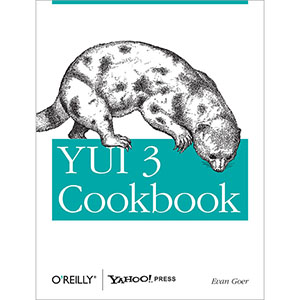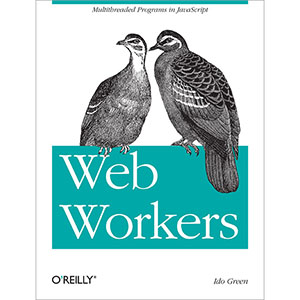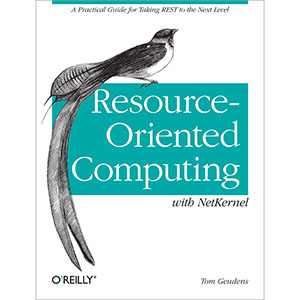| YUI 3 Cookbook Posted: 31 May 2012 05:38 AM PDT 
Book Description Solve a wide range of problems in your web application quickly and efficiently with the Yahoo! User Interface Library (YUI). With this definitive, getting-started guide to version 3 of the popular open source JavaScript library, you'll learn how to address many of the most common and challenging problems that web development presents. YUI 3 Cookbook introduces specific implementation patterns in the library, demonstrating granular solutions for everything from simple page effects to sophisticated web apps. Experienced users will learn how to create modules that load on demand; generate beautiful documentation; and write powerful and flexible Widgets, Models, and Views. - Build YUI applications anywhere, from desktop browsers to touch-enabled mobile phones and backend Node.js environments
- Learn how YUI scales with your code base, keeping it modular and organized
- Apply animations, drag-and-drop, and other fully cross-browser UI effects with just a few lines of code
- Understand YUI-powered DOM scripting, event management, and data transport
- Debug, profile, and unit test your JavaScript application
- Get a technical introduction to YUI, including module architecture, sandboxing, and component loading
- Build custom modules with YUI and publish them to the YUI Gallery
“I was surprised to find out how much I didn’t know until reading this book. There really isn’t a better resource for learning or updating your YUI skills.”
– Nicholas C. Zakas, Author and YUI Contributor Table of Contents
Chapter 1. Loading Modules
Chapter 2. DOM Manipulation
Chapter 3. UI Effects and Interactions
Chapter 4. Events
Chapter 5. Ajax
Chapter 6. CSS
Chapter 7. Infrastructure
Chapter 8. Using Widgets
Chapter 9. Utilities
Chapter 10. Server-Side YUI
Chapter 11. Universal Access
Chapter 12. Professional Tools Book Details - Paperback: 428 pages
- Publisher: O’Reilly Media (May 2012)
- Language: English
- ISBN-10: 1449304192
- ISBN-13: 978-1449304195
Note: There is a file embedded within this post, please visit this post to download the file. Related Posts 

|
| Web Workers: Multithreaded Programs in JavaScript Posted: 31 May 2012 05:33 AM PDT 
Book Description Web apps would run much better if heavy calculations could be performed in the background, rather than compete with the user interface. With this book, you'll learn how to use Web Workers to run computationally intensive JavaScript code in a thread parallel to the UI. Yes, multi-threaded programing is complicated, but Web Workers provide a simple API that helps you be productive without the complex algorithms. If you have an intermediate to advanced understanding of JavaScript— especially event handling and callbacks—you're ready to tackle Web Workers with the tools in this example-driven guide. - Start creating Web Workers and understand what they can and can't do
- Determine which browser versions support the API
- Use dedicated Web Workers for tasks that consume a lot of CPU, such as data parsing
- Explore use cases for creating inline Workers, such as encapsulating a web app in one page
- Create a shared Worker to communicate multiple web app instances to the server, and other uses
- Learn best practices for debugging Web Workers
- Apply Web Workers within the server-side Node environment
Table of Contents
Chapter 1. Overview
Chapter 2. How and Where Can We Use Web Workers?
Chapter 3. Dedicated Workers
Chapter 4. Inline Workers
Chapter 5. Shared Workers
Chapter 6. Debug Your Workers
Chapter 7. Web Workers Beyond the Browser: Node Book Details - Paperback: 60 pages
- Publisher: O’Reilly Media (May 2012)
- Language: English
- ISBN-10: 1449322131
- ISBN-13: 978-1449322137
Note: There is a file embedded within this post, please visit this post to download the file. Related Posts 

|
| Resource-Oriented Computing with NetKernel Posted: 31 May 2012 05:28 AM PDT 
Book Description Take resource-oriented computing out for a spin with this hands-on introduction to NetKernel, and discover how ROC can improve the way you design and implement software and software systems. Learn how ROC's new approach combines core ideas from the REST architectural style with the Unix development model. By using NetKernel to create and then string simple services together, you can develop complex systems that scale as easily as the Internet does. Author Tom Geudens helps you create several NetKernel modules right away, and then walks you through the results to demonstrate their effectiveness. - Create, test, and document Netkernel modules from scratch
- Learn the basic principles of ROC's abstract computing model
- Design an interface in NetKernel that lets you insert, update, delete, and select actions in MongoDB
- Use the Visualizer to trace information about root requests processed by NetKernel
- Handle resource requests with DPML—NetKernel's Declarative-Request Process Markup Language
- Compose modular XML documents with the XML Recursion Language (XRL)
- Build solutions using nCoDE in NetKernel's visual editor
Table of Contents
Part I: Getting Acquainted
Chapter 1. Stacking the Deck
Chapter 2. Incision, Right Here
Chapter 3. ROC Talk
Chapter 4. Humongous Fun
Chapter 5. Expanding Your Horizon Part II: Batteries Included
Chapter 6. DPML
Chapter 7. XRL
Chapter 8. nCoDE Part III: Appendixes
Appendix A. Getting and Installing NetKernel
Appendix B. Setting Up Your Own Apposite Repository
Appendix C. Running NetKernel as a Service
Appendix D. Locking Down Your NetKernel Instance
Appendix E. Source Version Control
Appendix F. Examples and Solutions Book Details - Paperback: 246 pages
- Publisher: O’Reilly Media (May 2012)
- Language: English
- ISBN-10: 1449322522
- ISBN-13: 978-1449322526
Note: There is a file embedded within this post, please visit this post to download the file. Related Posts 

|
| Orchard CMS: Up and Running Posted: 31 May 2012 05:18 AM PDT 
Book Description Use your C# skills to build your next website with Orchard, the popular content management system based on ASP.NET MVC. With step-by-step guidance, you'll learn your way around the Orchard environment by constructing a complete, real-world site throughout the course of this book. You'll create, manage, and display dynamic content with out-of-the-box functionality, and then build themes, modules, and widgets to customize the site. Author John Zablocki gets you started by showing you how to obtain and compile the Orchard source code, so you can more efficiently customize and manage the sites you create. - Create or extend Orchard content types to manage dynamic content
- Use alternate templates to change the way Orchard displays content
- Design a theme to define your website's look and feel
- Build custom modules when the Orchard Gallery doesn't have extensions you need
- Create reusable content pieces by creating widgets
- Explore options for adding multi-language support to a site
- Learn hosting options for your Orchard sites, including the cloud
- Package your custom themes and modules to share in Orchard Gallery
Table of Contents
Chapter 1. Getting Started with Orchard
Chapter 2. Creating and Managing Content
Chapter 3. Displaying Content
Chapter 4. Creating Themes
Chapter 5. Creating Modules
Chapter 6. Creating Widgets
Chapter 7. Localization
Chapter 8. Maintaining Orchard Sites Book Details - Paperback: 130 pages
- Publisher: O’Reilly Media (May 2012)
- Language: English
- ISBN-10: 144932021X
- ISBN-13: 978-1449320218
Note: There is a file embedded within this post, please visit this post to download the file. Related Posts 

|
| Getting Started with Dwarf Fortress Posted: 31 May 2012 05:10 AM PDT 
Book Description Dwarf Fortress may be the most complex video game ever made, but all that detail makes for fascinating game play, as various elements collide in interesting and challenging ways. The trick is getting started. In this guide, Fortress geek Peter Tyson takes you through the basics of this menacing realm, and helps you overcome the formidable learning curve. The book's focus is the game's simulation mode, in which you're tasked with building a dwarf city. Once you learn how to establish and maintain your very first fortress, you can consult the more advanced chapters on resource management and training a dwarf military. You'll soon have stories to share from your interactions with the Dwarf Fortress universe. - Create your own world, then locate a site for an underground fortress
- Equip your party of dwarves and have them build workshops and rooms
- Produce a healthy food supply so your dwarves won't starve (or go insane)
- Retain control over a fortress and dozens of dwarves, their children, and their pets
- Expand your fortress with fortifications, stairs, bridges, and subterranean halls
- Construct fantastic traps, machines, and weapons of mass destruction
Table of Contents
Chapter 1. Introduction
Chapter 2. Playing God
Chapter 3. First Steps
Chapter 4. Filling Dwarf Bellies
Chapter 5. Merchants and Trading
Chapter 6. Dwarf Resource Management
Chapter 7. Digging Deeper
Chapter 8. Industry
Chapter 9. Justice, Healthcare, and Vampires
Chapter 10. The Military
Chapter 11. Engineering Book Details - Paperback: 236 pages
- Publisher: O’Reilly Media (May 2012)
- Language: English
- ISBN-10: 1449314945
- ISBN-13: 978-1449314941
Note: There is a file embedded within this post, please visit this post to download the file. Related Posts 

|







Tidak ada komentar:
Posting Komentar